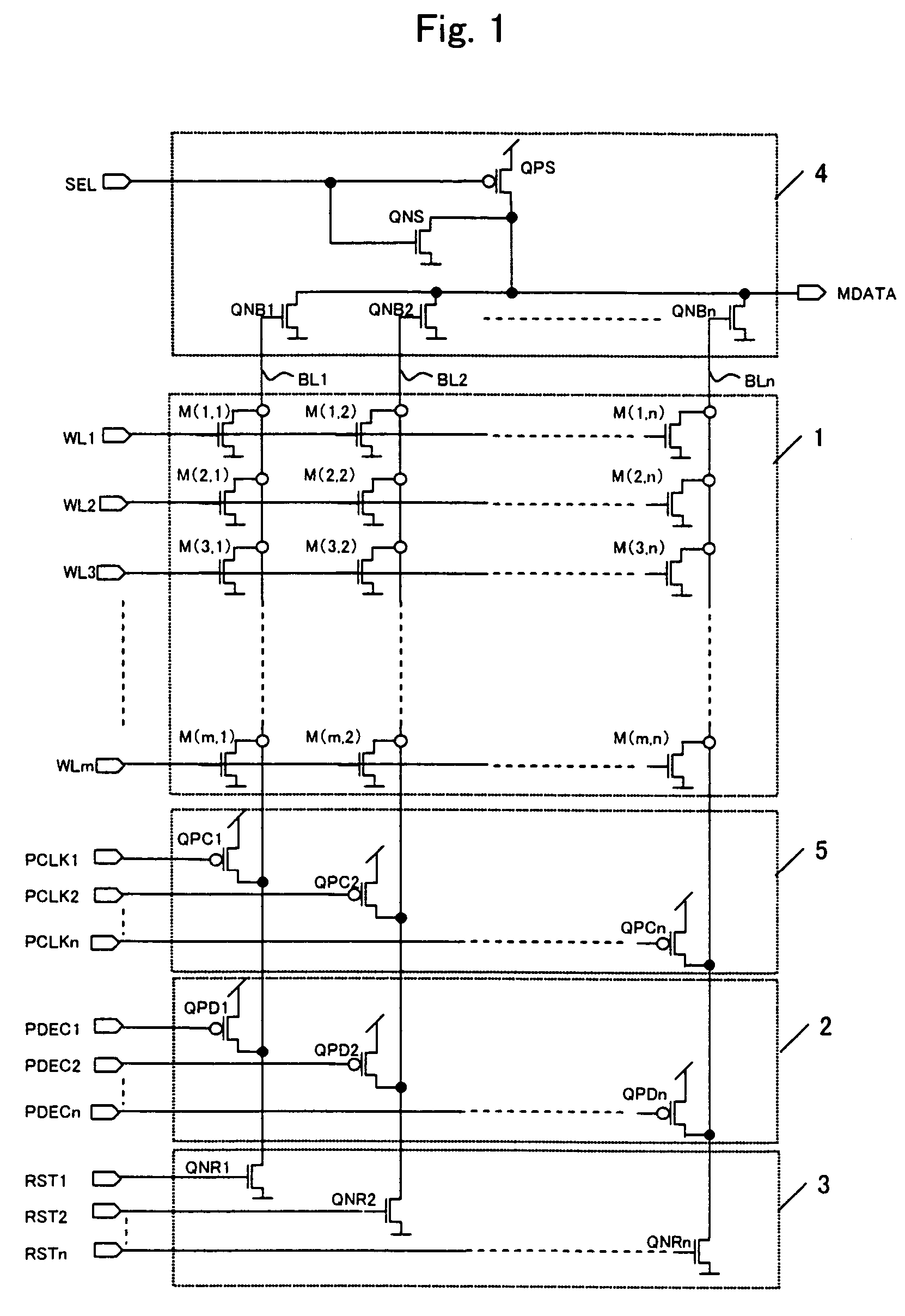Semiconductor memory device having bit line precharge circuit controlled by address decoded signals
a memory device and address decoding technology, applied in static storage, digital storage, instruments, etc., can solve the problems of large problem in the implementation of low-power semiconductor memory devices, impaired function of semiconductor memory devices, and increase not only the size of semiconductor memory devices but their production costs. , to achieve the effect of reducing the substrate bias effect, increasing not only the size of semiconductor memory devices
- Summary
- Abstract
- Description
- Claims
- Application Information
AI Technical Summary
Benefits of technology
Problems solved by technology
Method used
Image
Examples
first embodiment
[0064]FIG. 1 is a circuit diagram showing the configuration of a semiconductor memory device according to a first embodiment of the present invention.
[0065]The semiconductor memory device shown in FIG. 1 includes a memory cell array 1, a bit line charge circuit 2, a bit line reset circuit 3, a read circuit 4, and a bit line precharge circuit 5.
[0066]Since the memory cell array 1 is the same as that of the conventional art semiconductor memory device, the explanation of the same components will be omitted instead of giving the same reference numerals.
[0067]The bit line charge circuit 2 includes P-type MOS transistors QPDj (j=1 to n). With the P-type MOS transistors QPDj (j=1 to n), their gates are each connected to charge selection signal lines PDECj (j=1 to n), their sources are connected to power supply potential lines, and their drains are each connected to bit lines BLj (j=1 to n).
[0068]The ON-state currents of the P-type MOS transistors QPDj (j=1 to n) are set so as to become sm...
second embodiment
[0088]FIG. 3 is a circuit diagram showing the configuration of a semiconductor memory device according to a second embodiment of the invention.
[0089]The semiconductor memory device shown in FIG. 3 includes the memory cell array 1, the bit line reset circuit 3, the read circuit 4, a bit line precharge circuit 6, and a bit line charge circuit 7. Since the memory cell array 1, the bit line reset circuit 3, and the read circuit 4 are the same as those described in the first embodiment, the explanation of the same components thereof will be omitted instead of giving the same reference numerals.
[0090]The bit line precharge circuit 6 includes N-type MOS transistors QNCj (j=1 to n). As for the N-type MOS transistors QNCj (j=1 to n), their gates are each connected to precharge selection signal lines PCLKj (j=1 to n), their drains are connected to power supply potential lines, and their sources are each connected to bit lines BLj (j=1 to n).
[0091]The bit line charge circuit 7 includes N-type ...
third embodiment
[0107]FIGS. 5 and 6 are circuit diagrams showing the configuration of a semiconductor memory device according to a third embodiment of the invention.
[0108]As shown in FIG. 6, the semiconductor memory device according to the fourth embodiment includes a memory block 10, a memory block 11, and an output selection circuit 12.
[0109]As shown in FIG. 5, the memory blocks 10 and 11 are each constituted by the memory cell array 1, the bit line reset circuit 3, the read circuit 4, a bit line precharge circuit 8, and a bit line charge circuit 9. Since the memory cell array 1, the bit line reset circuit 3, and the read circuit 4 are the same as those described in the first embodiment, the explanation of the same components thereof will be omitted instead of giving the same reference numerals.
[0110]The bit line precharge circuit 8 includes P-type MOS transistors QPUj (j=1 to n) and N-type MOS transistors QNUj (j=1 to n).
[0111]As for the P-type MOS transistors QPUj (j=1 to n), their gates are co...
PUM
 Login to View More
Login to View More Abstract
Description
Claims
Application Information
 Login to View More
Login to View More - R&D
- Intellectual Property
- Life Sciences
- Materials
- Tech Scout
- Unparalleled Data Quality
- Higher Quality Content
- 60% Fewer Hallucinations
Browse by: Latest US Patents, China's latest patents, Technical Efficacy Thesaurus, Application Domain, Technology Topic, Popular Technical Reports.
© 2025 PatSnap. All rights reserved.Legal|Privacy policy|Modern Slavery Act Transparency Statement|Sitemap|About US| Contact US: help@patsnap.com



